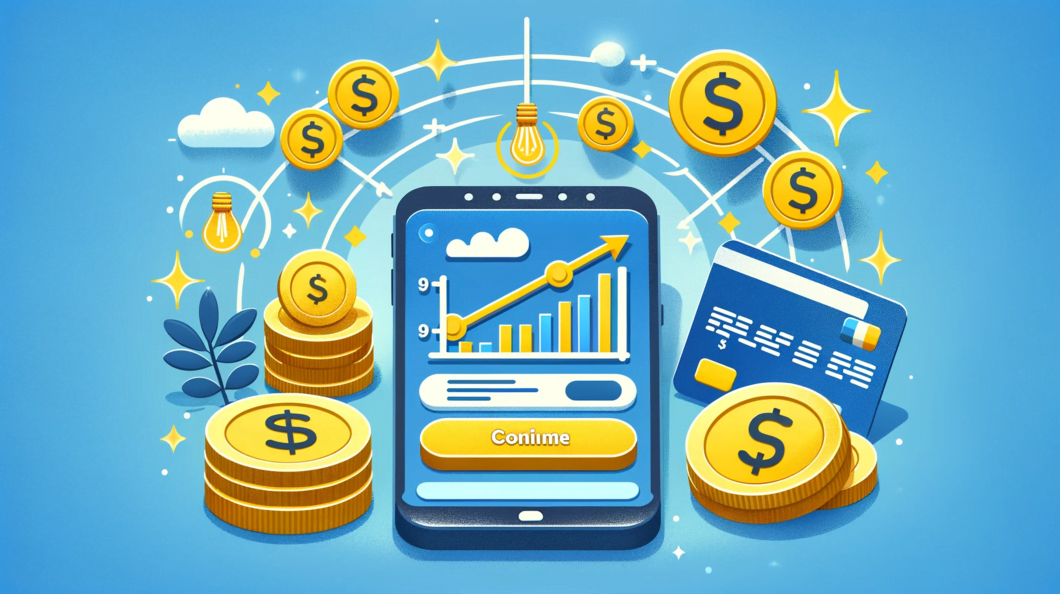In today’s digital economy, app monetisation is crucial for mobile applications, especially in the growing field of peer-to-peer (P2P) payment apps. This trend is evidenced by the surge in app downloads and revenue. More than just relying on mobile technology, this increase highlights diverse monetisation strategies like in-app purchases, targeted advertising, subscriptions, and affiliate marketing, offering multiple profitability avenues. This article delves into build a P2P payment app, exploring these monetisation methods in the ever-evolving digital landscape, guiding developers in creating valuable user experiences and sustainable revenue streams.
Understanding App Monetization
App monetization is a pivotal process in the app development lifecycle, where developers harness the potential of their mobile applications to generate revenue. This transformation elevates a mobile app from being just a digital offering to a sustainable, profit-generating business entity. Essentially, monetization is the art of converting user engagement and app functionality into tangible financial returns.
The role of app monetization in today’s digital ecosystem is immensely significant. According to recent data, the global app market has experienced an extraordinary surge in both user downloads and generated revenue. To illustrate, in 2020, the world saw 218 billion app downloads – a remarkable 55% increase from 2016. This upward trend is also reflected in financial terms, with a 148% rise in consumer spending on mobile apps, culminating in a staggering $143 billion in the same year. These figures not only demonstrate the ever-expanding influence of mobile apps but also highlight the vast potential they hold for revenue generation.
For app developers, monetization is far more than a mere pursuit of profit. It represents the key to sustainability and growth in an intensely competitive market. Effectively monetizing an app can be the deciding factor between its success and obscurity. Developers have a spectrum of strategies at their disposal, including direct sales, in-app purchases, subscriptions, and advertising. Each of these avenues offers distinct opportunities for revenue generation, and the choice among them can profoundly influence the app’s market performance, user engagement, and overall financial health.
In the dynamic world of app development, monetization transcends its role as a financial imperative. It emerges as a strategic element that not only shapes the user experience but also determines the app’s long-term viability. As the app market continues to evolve with technological advancements and changing user preferences, the ability to understand and implement effective monetization strategies becomes increasingly crucial. It is these strategies that will ultimately anchor the success of apps in the ever-changing landscape of the digital economy.
Strategies for Monetizing Your App
In the dynamic world of mobile applications, selecting the right monetization strategy is crucial for success. The most common strategies include in-app purchases, advertising, subscriptions, and affiliate marketing. Each of these approaches comes with its unique set of advantages and challenges.
In-App Purchases
In-app purchases are a direct monetization method where users pay for additional features or content within the app. This strategy is particularly effective in gaming and utility apps, where users can buy extra functionalities, virtual goods, or additional content.
Pros:
- High Revenue Potential: Can generate significant income per user, especially if the app has a strong user engagement.
- Enhances User Experience: Offers value-added services or features that can improve the overall app experience.
Cons:
- Risk of Alienating Users: If not implemented thoughtfully, it can lead to a negative user experience, especially if users feel forced to make purchases.
- Dependency on a Small User Base: Often, a small percentage of users contribute to the majority of in-app purchase revenues.
Advertising
Advertising involves displaying ads within the app. This can be in the form of banner ads, video ads, or native ads that are integrated into the app’s interface.
Pros:
- Steady Revenue Stream: Provides a consistent source of income, especially for apps with a large user base.
- Free Usage: Allows users to access the app for free, which can increase the user base.
Cons:
- Can Impair User Experience: Intrusive ads can annoy users, potentially leading to app uninstalls.
- Fluctuating Revenue: Earnings depend on the ad model and user engagement, which can be variable.
Subscriptions
Subscription models charge users a recurring fee for continued access to the app or its premium features. This is common in content-driven apps like news, music, and video streaming services.
Pros:
- Predictable Revenue: Offers a steady and predictable source of income.
- Customer Loyalty: Encourages user retention and loyalty over time.
Cons:
- High User Expectations: Requires continuous delivery of high-quality content or features.
- Churn Rate: Risk of users unsubscribing if they don’t find enough value.
Affiliate Marketing
Affiliate marketing involves promoting third-party products or services within the app and earning a commission for each sale or referral.
Pros:
- Additional Revenue Stream: Provides an extra source of income without direct selling.
- Enhances Content: Can add value to the app if products are relevant to the user base.
Cons:
- Requires Relevant Partnerships: Success depends on finding suitable affiliate products that resonate with the app’s audience.
- Balance is Key: Over-promotion can lead to a negative user experience.
Each monetization strategy offers different pathways to revenue generation, and the choice largely depends on the app’s nature, target audience, and overall goals. A successful monetization strategy often involves a combination of these methods, tailored to the app’s specific context and user expectations.
Leveraging Social Media and Influencers
In the digital age, social media and influencers have become pivotal in promoting apps and enhancing their monetization potential. These platforms and personalities can significantly boost app visibility, drive downloads, and ultimately increase revenue.
Utilizing Social Media for App Promotion
Social media platforms offer a vast, diverse audience, making them ideal for app promotion. Strategies include:
- Targeted Advertising: Platforms like Facebook and Instagram provide tools for targeted advertising, allowing developers to reach specific demographics based on interests, behaviors, and more.
- Engaging Content: Creating compelling content that resonates with the audience can increase app awareness and interest. This includes posts, stories, and interactive elements like polls or quizzes.
- Community Building: Social media enables developers to build communities around their apps, fostering engagement and loyalty. Regular updates, behind-the-scenes glimpses, and user interaction are key.
Pros:
- Wide Reach: Access to a vast audience.
- Targeted Marketing: Ability to reach specific user groups.
- Cost-Effective: Many social media marketing strategies can be implemented with a relatively low budget.
Cons:
- High Competition: Standing out in a crowded space can be challenging.
- Constant Evolution: Requires keeping up with ever-changing algorithms and trends.
Influencer Marketing in App Promotion
Influencers can play a significant role in app promotion due to their credibility and the trust they have built with their followers.
- Collaborations and Endorsements: Partnering with influencers for app endorsements can lead to increased downloads. Influencers can create content that showcases the app’s features in a relatable and engaging way.
- Sponsored Content: Paying influencers to create sponsored content about the app can reach a broader audience.
Pros:
- Trust and Credibility: Influencers’ recommendations can carry significant weight with their followers.
- Targeted Reach: Influencers often have niche audiences that can be directly relevant to the app’s target market.
Cons:
- Cost: Popular influencers can be expensive to engage with.
- Risk of Mismatch: Partnering with the wrong influencer can lead to ineffective campaigns and wasted resources.
Leveraging social media and influencers is a dynamic and potentially highly effective strategy for app promotion. It requires a strategic approach, creativity in content creation, and choosing the right platforms and partners to maximize the potential for app downloads and engagement.
Navigating App Store Fees and Policies
For app developers, understanding and navigating the landscape of app store fees and policies is crucial for effective monetization. These fees and policies can significantly impact the revenue potential and strategies employed for monetizing an app.
App Store Fees: A Significant Consideration
Most major app stores, like Apple’s App Store and Google Play, charge a standard fee on the revenue generated through the app. This fee typically ranges around 15-30% of the revenue. For instance, Apple and Google have policies where they take a 30% cut from in-app purchases. This substantial share can influence how developers price their products and services within the app. It’s essential for developers to factor in these fees when calculating their potential earnings and deciding on pricing strategies.
Policies and Their Impact on Monetization
App store policies also play a critical role in shaping monetization strategies. These policies govern various aspects, including the types of in-app purchases allowed, subscription models, and the use of third-party payment systems. For example, certain app stores might have restrictions on the types of digital goods that can be sold through in-app purchases. Violating these policies can lead to the app being removed from the store, which underscores the importance of compliance.
Strategic Adjustments for Maximizing Revenue
Developers need to strategically adjust their monetization models to align with these fees and policies. This might involve exploring alternative monetization strategies that are less impacted by app store fees, such as advertising or affiliate marketing. Additionally, developers can consider pricing adjustments to offset the fees charged by app stores.
In summary, app store fees and policies are critical factors in the app monetization process. Developers must stay informed and compliant with these guidelines while creatively exploring monetization strategies that maximize revenue within these constraints.
Emerging Trends: NFTs and Web 3.0
The landscape of app monetization is rapidly evolving with the advent of Web 3.0 technologies and Non-Fungible Tokens (NFTs). These innovations are opening new avenues for developers to generate revenue and offer unique value to users.
Incorporating NFTs in Monetization
NFTs represent a groundbreaking shift in digital ownership and monetization. These digital assets are unique, indivisible, and verifiable, making them ideal for creating exclusive, collectible content within apps. For instance, an app could issue limited edition digital artwork or special in-app features as NFTs, which users can purchase, collect, or trade. This not only creates a new revenue stream but also adds a layer of engagement and community building around the app. NFTs are emerging as a lucrative option for app monetization, with the potential for high-value transactions contributing significantly to overall revenue.
Web 3.0 and Its Impact on App Monetization
Web 3.0, characterized by decentralized and blockchain-based technologies, is set to transform app monetization. This new internet era emphasizes user ownership and control, which aligns perfectly with the ethos of app monetization. For example, decentralized apps (DApps) on blockchain platforms can offer more secure, transparent, and efficient ways to handle transactions, subscriptions, and user data. This can lead to enhanced trust and loyalty among users, thereby potentially increasing revenue. Moreover, Web 3.0 technologies enable microtransactions and tokenization, offering more flexibility and opportunities in monetization models.
The Synergy of NFTs and Web 3.0
The combination of NFTs and Web 3.0 technologies presents a powerful synergy for app developers. NFTs can be integrated into DApps, providing a seamless and secure experience for users engaging in digital collectibles and transactions. This integration not only enhances the app’s value proposition but also aligns with the growing trend of digital ownership and decentralized economies.
Incorporation of NFTs and the adoption of Web 3.0 technologies represent the forefront of innovation in app monetization. These trends offer exciting opportunities for developers to explore new revenue models while providing unique and valuable experiences to users.
Case Studies: Successful Monetization Examples
Examining real-world examples provides invaluable insights into the practical application and effectiveness of various app monetization strategies. Here, we explore a few case studies that demonstrate different approaches to monetization and their outcomes.
Case Study 1: Freemium Model in a Gaming App
A notable example of successful monetization is a mobile gaming app that adopted the freemium model. Users could download and play the game for free, but additional features, levels, and in-game items were available for purchase.
- Strategy: The app enticed users with engaging, free content, then offered premium features for a fee. This approach capitalized on user engagement and the desire for enhanced gameplay.
- Outcome: The app saw a significant increase in revenue from in-app purchases, with a substantial portion of players opting for the premium features, demonstrating the effectiveness of the freemium model in the gaming sector.
Case Study 2: Subscription-Based Fitness App
Another success story is a fitness app that implemented a subscription model. Users could access basic features for free, but a subscription was required for personalized workout plans and advanced tracking.
- Strategy: The app focused on providing value through personalized content, making the subscription fee seem like a worthwhile investment for dedicated users.
- Outcome: The app experienced a steady increase in long-term subscribers, leading to a predictable and sustainable revenue stream. This case underscores the potential of subscription models in apps offering personalized, value-added services.
Case Study 3: Ad-Supported Utility App
A utility app successfully monetized through an ad-supported model. The app was free to use, but featured banner and video ads.
- Strategy: By offering a free, useful service, the app attracted a large user base. The ads were strategically placed to be noticeable without being intrusive.
- Outcome: The app managed to generate significant ad revenue due to its high user engagement and retention rates. This example highlights the viability of advertising as a monetization strategy, especially for apps with broad appeal and frequent usage.
These case studies illustrate the diversity of monetization strategies and their potential for success. They emphasize the importance of aligning the monetization model with the app’s content, target audience, and user experience to achieve financial success.
Conclusion
In this exploration of app monetization, we’ve uncovered various strategies that can transform a mobile application from a simple digital offering into a robust revenue-generating platform. From in-app purchases and advertising to subscriptions and affiliate marketing, each approach offers unique benefits and challenges. The key takeaways include the importance of aligning monetization strategies with the app’s nature and user base, ensuring a balance between revenue generation and user experience.
The rise of social media and influencer marketing has also been highlighted as a game-changer in promoting apps and driving downloads. Additionally, emerging trends like NFTs and Web 3.0 technologies are opening new frontiers in app monetization, offering innovative ways to engage users and generate revenue.
The case studies presented illustrate the practical application and success of these strategies in the real world, emphasizing the diversity and potential of monetization methods.
As the digital landscape continues to evolve, staying abreast of market trends and adapting to new technologies and user preferences is crucial. The right monetization strategy not only ensures financial success but also enhances the overall value and longevity of the app. In conclusion, effective monetization is a dynamic and ongoing process, requiring creativity, adaptability, and a keen understanding of the digital economy.
FAQs
Integrating blockchain tech opens up diverse revenue avenues like transaction fees in crypto, smart contract deployment charges, and tokenization services. It’s a game-changer for tapping into decentralized finance (DeFi) ecosystems, ensuring secure, transparent transactions that attract a tech-savvy user base.
Tokenization is key. By creating native tokens, you can incentivize user engagement and offer premium features. It’s not just about creating a digital currency; it’s about building an ecosystem where your tokens can be used for rewards, staking, or accessing exclusive services.
Absolutely! NFTs (Non-Fungible Tokens) are more than digital art; they’re unique assets that can represent ownership or membership. Incorporating NFTs into your app can create new revenue lines through NFT minting fees, trading commissions, and exclusive access to services or products.
Linking with DeFi platforms means tapping into liquidity pools, yield farming, and staking opportunities. This not only diversifies your revenue but also enhances user engagement by offering them lucrative ways to grow their assets directly through your app.
While crypto monetization is lucrative, it’s not without risks like market volatility and regulatory changes. It’s crucial to implement robust risk management strategies, stay updated with compliance laws, and educate your users about the risks and rewards of crypto transactions.



